10th Maths Book Back Question and Answers – Chapter 4 Exercise 4.4:
Samacheer Kalvi 10th Standard Maths Book Back Questions with Answers PDF uploaded and the same given below. Class-tenth candidates and those preparing for TNPSC exams can check the Maths Book Back Answers PDF below. Samacheer Kalvi Class 10th Std Maths Book Back Answers Chapter 4 Geometry Exercise 4.4 Solutions are available below. Check the complete Samacheer Kalvi 10th Maths – Geometry Ex 4.4 Book Back Answers below:
We also provide class 10th other units Maths Book Back One, Two, and Five Mark Solutions Guide on our site. Students looking for the 10th standard Maths Ex 4.4- Geometry Book Back Questions with Answer PDF
For the complete Samacheer Kalvi 10th Maths Book Back Solutions Guide PDF, check the link – Samacheer Kalvi 10th Maths Book Back Answers
Samacheer Kalvi 10th Maths Book Back Answers – Ex 4.4 Geometry
Samacheer Kalvi 10th Maths Book Subject One Mark, Two Mark, Five Mark Guide questions and answers are below. Check Maths Book Back Questions with Answers. Take the printout and use it for exam purposes.
For Samacheer Kalvi 10th Maths Book PDF, check the link – 10th Maths Book PDF
Chapter 4
Exercise 4.4 Geometry
1. The length of the tangent to a circle from a point P, which is 25 cm away from the centre is 24 cm. What is the radius of the circle?
Solution:
242 + r2 = 252
576 + r2 = 625
r2 = 625 – 576
= 49
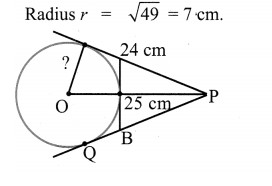
2. ∆LMN is a right angled triangle with ∠L = 90°. A circle is inscribed in it. The lengths of the sides containing the right angle are 6 cm and 8 cm. Find the radius of the circle.
Solution:
∆LMN,
By Pythagoras theorem,
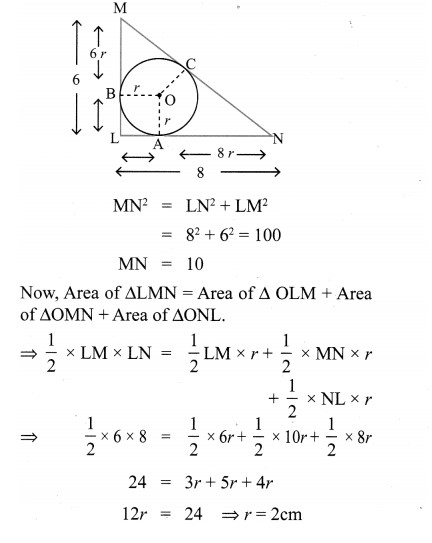
3. A circle is inscribed in ∆ABC having sides 8 cm, 10 cm and 12 cm as shown in figure, Find AD, BE and CF.
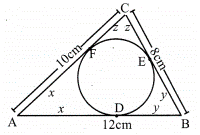
Solution:
We know that the tangents drawn from are external point to a circle are equal.
Therefore AD = AF = x say.
BD = BE = y say and
CE = CF = z say
Now, AB = 12 cm, BC = 8 cm, and CA= 10 cm.
x + y = 12, y + z = 8 and z + x = 10
(x + y) + (y + z) + (z + x) = 12 + 8 + 10
2(x + y + z) = 30
x + y + z = 15
Now, x + y = 12 and x + y + z = 15
12 + z = 15 ⇒ z = 3
y + z = 8 and x + y + z = 15
x + 8 = 15 ⇒ x = 7
and z + x = 10 and x + y + z = 15
10 + y = 15 ⇒ y = 5
Hence, AD = x = 7 cm, BE = y = 5 cm
and CF = z = 3 cm.
4. PQ is a tangent drawn from a point P to a circle with centre O and QOR is a diameter of the circle such that ∠POR = 120° . Find ∠OPQ.
Solution:
∠POR + ∠POQ = 180° (straight angle = 180°)
∴ 120 +∠POQ = 180°
∠POQ = 60°
∠OQP = 90° (∵ radius is ⊥r to the tangent at the point of contact)
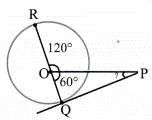
∴ ∠POQ + ∠PQO + ∠OPQ = 180° (∵ sum of the 3 angles of a triangle is 180°)
∴ 60 + 90 + ∠OPQ = 80°
∠OPQ = 180° – 150° = 30°
5. A tangent ST to a circle touches it at B. AB is a chord such that ∠ABT = 65°. Find ∠AOB , where “O” is the centre of the circle.
Solution:
In the figure,
∠OBT = 90° (∵OB-radius, BT – Tangent)
= 115°
∴ ∠OBA = 90° – 65°
∠OAB = 25° (OA = OB)
∴ ∠AOB = 180° – 50°
= 130°
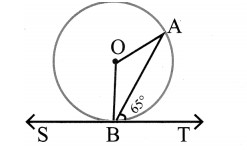
6. In figure, O is the centre of the circle with radius 5 cm. T is a point such that OT = 13 cm and OT intersects the circle E, if AB is the tangent to the circle at E, find the length of AB.

Solution:
In ∆OPT, OP = r = 5 cm
OT = 13 cm
PT = 12 cm
In ∆OPA, OA2 = OP2 + AP2 ………….. (1)
In ∆OAE, OA2 = OE2 + AE2 …………. (2)
Equating (1) and (2),
OP2 + AP2 = OE2 + AE2 (∵ OP = OE = r)
∴ AP = AE
Parallel BQ = EB
In ∆AET, AT2 = AE2 + ET2
∴ ET2 = AT2 – AE2 = (AT + AE) (AT – AE)
∴ ET2 = (AT + AP) (AT – AE) (∵ AE = AP)
∴ 8 × 8 = 12 × (AT – AE)
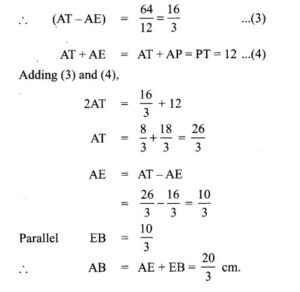
7. In two concentric circles, a chord of length 16 cm of larger circle becomes a tangent to the smaller circle whose radius is 6 cm. Find the radius of the larger circle.
Solution:
AB = 16 cm given
CA = CB(∵ OC ⊥r AB)
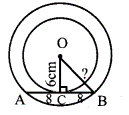
OB2 = OC2 + BC2
= 62 + 82
= 36 + 64 = 100
OB = Radius of the larger circle = 100−−−√ = 10 cm.
8. Two circles with centres O and O’ of radii 3 cm and 4 cm respectively intersect at two points P and Q, such that OP and O’P are tangents to the two circles. Find the length of the common chord PQ.
Solution:
Given: OP = OQ = 4
O’P = O’Q = 3
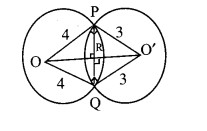
OO’ is the perpendicular bisector of chord PQ.
Let R be the point of intersection of PQ and OO’.
Assume PR = QR = x and OR = y
In OPO’, OP2 + O’P2 = (OO’)2 ⇒ OO’
= 42+32−−−−−−√ = 5
OR = y ⇒ OR = 5 – y
In ∆OPR, PR2 + OR2 = OP2 ⇒ x2 + y = 42 ……….. (1)
In ∆O’PR, PR2 + O’R2 = O’P2 ⇒ x2 + (5 – y)2 = 9 ………….(2)
(1) – (2)=> y2 – (25 + y2 – 10y) = 16 – 9
⇒ y2 – 25 – y2 + 10y = 7 .
⇒ 10y = 25 + 7 ⇒ 10y =32
⇒ y =3.2
Substituting y = 3.2 in (1), we get x = 42−3.22−−−−−−−√
x = 2.4
PQ = 2x ⇒ PQ = 4.8 cm
9. Show that the angle bisectors of a triangle are concurrent.
Solution:
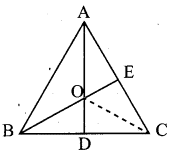
In ∆ABC, let AD, BE are two angle bisectors.
They meet at the point ‘O’
We have to prove that = ACCD=AOOD
Construct CO to meet the intersecting point O from C.
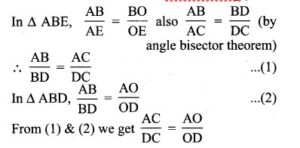
Hence proved.
10. In ∆ABC, with ∠B = 90°, BC = 6 cm and AB = 8 cm, D is a point on AC such that AD = 2 cm and E is the midpoint of AB. Join D to E and extend it to meet at F. Find BF.
In the figure ∆ABC, ∆EBF are similar triangles.
Solution:
Consider DABC, Then D, E, F are respective points on the sides CA, AB and BC. By constrution D, E, F are collinear.
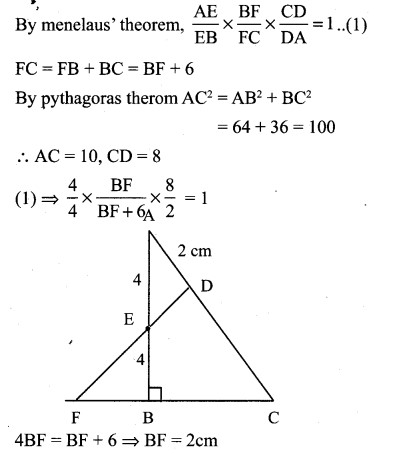
11. An artist has created a triangular stained glass window and has one strip of small length left before completing the window. She needs to figure out the length of left out portion based on the lengths of the other sides as shown in the figure.
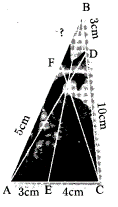
Solution:
In the figure, let O be the concurrent point of the angle bisectors of the three angles.
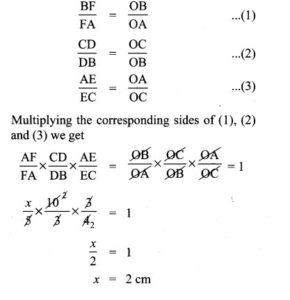
12. Draw a tangent at any point R on the circle of radius 3.4 cm and centre at P?
Solution:
Radius = 3.4 cm
Centre = P
Tangent at any point R.
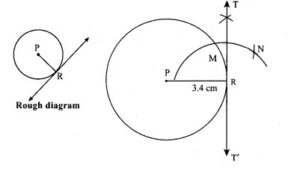
Construction:
Steps:
(1) Draw a circle with centre P of radius 3.4 cm.
(2) Take a point R on the circle. Join PR.
(3) Draw ⊥r line TT1 to PR. Which passes through R.
(4) TT1 is the required tangent.
13. Draw a circle of radius 4.5 cm. Take a point on the circle. Draw the tangent at that point using the alternate segment theorem.
Solution:
Construction:
Steps:
(1) With O as the centre, draw a circle of radius 4.5 cm.
(2) Take a point R on the circle. Through R draw any chord PR.
(3) Take a point Q distinct from P and R on the circle, so that P, Q, R are in anti-clockwise direction. Join PQ and QR.
(4) Through R drawn a tangent TT1 such that ∠TRP = ∠PQR.
(5) TT1 is the required tangent.
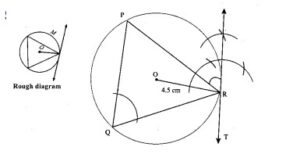
14. Draw the two tangents from a point which is 10 cm away from the centre of a circle of radius 5 cm. Also, measure the lengths of the tangents.
Solution:
Radius = 5 cm
The distance between the point from the centre is 10 cm.
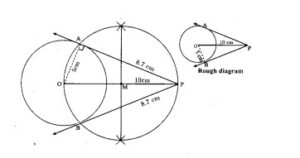
Construction:
Steps:
(1) With O as centre, draw a circle of radius 5 cm.
(2) Draw a line OP =10 cm.
(3) Draw a perpendicular bisector of OP which cuts OP at M.
(4) With M as centre and MO as radius, draw a circle which cuts previous circle at A and B.
(5) Join AP and BP. AP and BP are the required tangents. Thus length of the tangents are PA and PB = 8.7 cm.
Verification:
In the right triangle ∠POA;
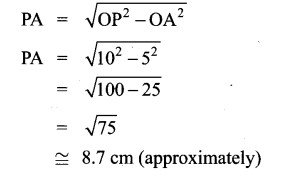
15. Take a point which is 11 cm away from the centre of a circle of radius 4 cm and draw the two tangents to the circle from that point.
Solution:
Radius = 4 cm
The distance of a point from the center =11 cm.
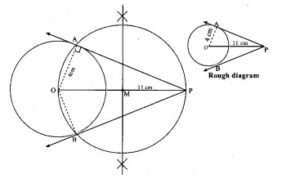
Construction:
Steps:
(1) With centre O, draw a circle of radius 4 cm.
(2) Draw a line OP = 11 cm.
(3) Draw a ⊥r bisector of OP, which cuts atM.
(4) With M as centre and MO as radius, draw a circle which cuts previous circle at A and B.
(5) Join AP and BP. AP and BP are the required tangents. Thus length of the tangents are PA = PB = 10.2 cm.
Verification:
In the right triangle
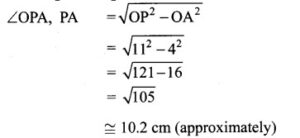
16. Draw the two tangents from a point which is 5 cm away from the centre of a circle of diameter 6 cm. Also, measure the lengths of the tangents.
Solution:
Diameter = 6 cm
Radius = 62 = 3 cm.
The distance between the centre and the point is 5 cm.
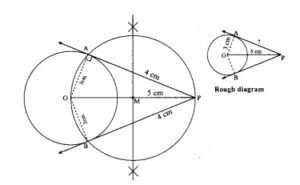
Construction:
Steps:
(1) With centre O, draw a circle of radius , 3cm.
(2) Draw a line OP = 5 cm.
(3) Draw a bisector of OP, which cuts OP and M.
(4) With M as centre and MO as radius draw a circle which cuts previous circle at A and B.
(5) Join AP and BP. AP and BP are the required tangents. Thus length of the tangents are PA = PB = 4 cm
Verification:
In the right triangle ∆OPA,
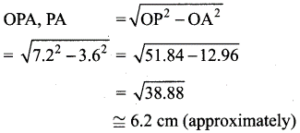
17.Draw a tangent to the circle from the point P having radius 3.6 cm, and centre at O. Point P is at a distance 7.2 cm from the centre.
Radius 3.6 cm.
Solution:
Distance from the centre to the point is 7.2 cm.
Construction:
Steps:
(1) Draw a circle of radius 3.6 cm with centre O.
(2) Draw a line OP = 7.2 cm.
(3) Draw a perpendicular bisector of OP, which cuts OP at M.
(4) With M as centre and MO as radius, draw a circle which cuts previous circle at A and B.
(5) Join AP and BP. AP and BP are the required tangents. Thus length of the tangents are PA = PB = 6.2 cm.
Verification:
In the right triangle.
Other Important Links for 10th Maths Book Back Answers Solutions:
For 10th Maths Chapter 4 book back question and answers, check the link – Samacheer kalvi 10th Maths Chapter 4 Geometry
Click here for the complete Samacheer Kalvi 10th Maths Book Back Solution Guide PDF – 10th Maths Book Back Answers
